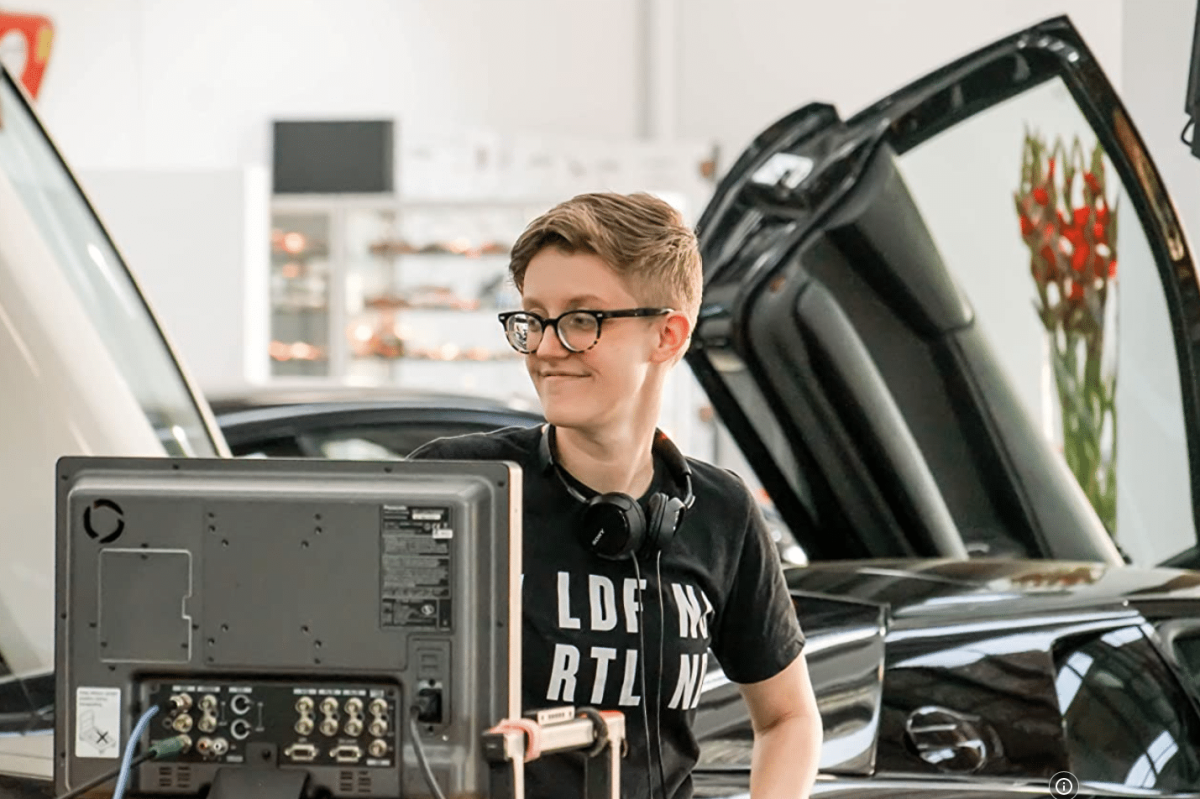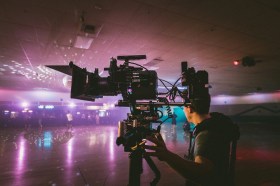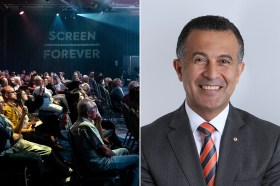A while back, I was on set directing a commercial product spot. At lunch everything was going smoothly. Three hours later, a bolt from the blue hit in the form of a snap lockdown. Not with a day or two notice, but five hours. Instead of finishing the day’s shotlist, ‘Hollywood wrapping’ our set overnight, and coming back the next day to finish shooting the rest, we had a few short hours to shoot everything we could, and pack down and bump out and get home.
Because we were working with a child as well as adults, much of the day had been structured around child legal requirements for limited hours and long breaks at regular intervals. Shots had been scheduled accordingly, so the footage we had was certainly not enough to form a complete piece. While my producer talked to the DP and crew about what time and assistance they’d need to get packed up, I talked to the client liaison about what sections of the final video they MOST wanted and needed. We decided we had about two hours to roll, and would shoot the rest of the adult’s parts and ‘cheat’ a few scenes with an adult instead of the planned child.
I picked a half dozen shots from my existing shotlist, came up with a few new ones, then presented it all to my DP and asked what order was best for set-up efficiency. We flew through the work as fast as could be safely done, packed up, and got out, everyone a bit in shock but working like the consummate professionals they are.
As we worked through the edit remotely (which included me trying to read notes more chickenscratch-y than usual), we were able to put together about 85% of the planned content, including all the most crucial parts, from only 50% of the shoot. I was happy, but most importantly the client was thrilled.
While execution is absolutely down to having a great team around me, if my skills hadn’t been up to par, we could have floundered more, or not had a coherent end product. Much of what enabled me to pivot quickly was my experience in the creative space, from directing narrative fiction to story producing reality TV.
In the last year I’ve been doing more corporate and commercial directing work than before, including work with bigger, international companies. I’m not about to dump narrative fiction for commercial directing; they are different worlds, and my heart and skills are best in the former. But many of the skills overlap, and we can learn a lot from one which carries over to the other. I want to look at three of the biggest crossover skills: turning on a dime, holding on not-too-tightly to your vision, and valuing your team.
Read: Welcome to YouTube’s mysterious Dust Channel
(For the sake of this post we’ll take budget out of the equation. Of course, you can sometimes solve by ‘throwing money at the problem’ but sometimes you can avoid money loss if you’re good enough at the above skills, which are required on anything from student shoots to Marvel movies. Plenty of big narrative/fiction shoots have money piles as big as corporate or commercial work, but most of us work our way up through both worlds, and the learning curve at comparable levels is the same. The three skills are useful at every budget level in both worlds.)
1. Turning on a Dime
It’s broad generalisation to say ‘creative filmmaking faces more unique roadblocks than corporate or commercial filmmaking’ but it’s often true. Roadblocks pop up more in creative spaces because filming duration and conditions are drastically different.
Corporate spots and commercials usually run for days, not months. They are often in controlled environments or studio spaces. The team is usually a handful of people instead of dozens to hundreds. If an actor falls ill, they are replaced. If a location is unavailable, you can use a similar one nearby which doesn’t need to ‘match’ anything. People work to the shoot’s strict schedule and needs or they aren’t hired for the project.
On long TV fiction shoots and films such as documentaries, Richard Linklater’s Boyhood, anything the elder Coppola makes, etc., you shoot in blocks spread over years. During that time, the DP needs a week off for their daughter’s wedding; the 1AD lands in the hospital; an actor’s family member passes away; catering gives half the crew a nasty case of norovirus; some producer in a swanky office 1,000 miles away very wrongly decides to fire half your PA team to save money; a script rewrite or wardrobe disaster necessitates reshooting a scene from weeks ago; a freak accident wipes multiple SD cards. All this and more has happened on shoots I’ve worked. (The footage wipe was ascribed to ‘super powerful magnets’ and ‘a haunted location’ – your theory may vary.) All these required rejiggering everything from schedule to budget to contracts to the script itself, sometimes all of the above.
While many logistics are handled by wonderful ADs and producers, a director must shift gears, too. What does it mean for your shotlist and blocking rehearsal if you’re filming in a backup location? How do you engage with actors if you’re shooting a scene which was meant to be two weeks from now, the dialogue has changed, or they need emotional preparation before shooting heavy material? What do you do when the lensing looks nothing like what pre-vis promised? How do you react if you’re halfway through scene coverage and realise you screwed up, and the shot you’ve spent 40 minutes setting up crosses a line and will cause problems in editing? What if halfway through a scene you’re out of time and must drop three of your remaining four shots: which shot is more important for the edit? the emotional beats? the character arc? What do you do if the answer to those questions are all different shots?
You have to think fast, send a quick prayer to all gods you do or don’t believe in, and commit to your choices. Then, however you feel about it, confidently, clearly communicate your choices to all parties.
Depending on the situation, you or your AD may make an announcement: ‘OK folks, we are going to [insert overview here], so let’s start with [specific actionable items your AD can facilitate]’. EG ‘We are going to drop the wides and concentrate on a medium two-shot. After that we’ll pick up one closeup of Actor A’s hand stubbing out her cigarette. IF we have time we will do one of the two planned closeups on Actor B. While camera and lights get set for the two-shot, the director will chat to the actors. Everyone else see department heads for information about bumping out anything we don’t need.’ Ask if anyone has questions, then light a fire under it.
Which is exactly what we did when lockdown fell like a hammer smashing all our beautiful preparation to bits. Two minutes of hand-wringing and double checking that we couldn’t, in fact, finish the shoot as planned. Then deep breath, massive pivot, decisions and communication flying through the air.
When you’re moving that quickly, you’ve got to be pragmatic and let go of things including shots you really wanted, emotional beats your actor would have nailed, lighting setups you had painstakingly studied. The better you know your creative vision and your processes, the better you’ll be able to jettison shots and scenes as needed. It won’t be painless, but it will get you through.
‘Know what you want’ applies to all aspects of directing. I once worked on a short film with a director who had a firm grasp on what performance he wanted from the actors … and nothing else. He didn’t know what angles or framing he preferred, he didn’t care about makeup and wardrobe, he had no strong opinions on lighting and colour. He thought he would ‘leave that up to those departments.’
Perhaps he even congratulated himself on being generous or ‘collaborative,’ but all he did was cause confusion. It created a power vacuum which led to the DP essentially directing all shots, the gaffer trying to direct the lighting, makeup being done wrong for the lighting, etc. (It finally climaxed in one of the single biggest fuckups I have ever seen on a film set, which would have turned full-on fistfight had not a crew member intervened. But that’s a story for a different time.) Point is: know something about every department, and care about all of it.
Know and care, and be willing to hold out for what matters. Lulu Wang was given offers to make The Farewell with a few key changes, including casting a Big Name White Guy. She stuck to her guns, passing on Netflix to eventually sign with A24 because they let her keep the core of her vision.
Absolutely know what you want and be willing to fight for it in this industry, so long as you retain willingness and ability to drop the fight when it becomes harmful or counter-productive. The tricky part is being careful a firm grip doesn’t become a stranglehold.
2. Hold On (not too tightly) To Your Creative Vision
Every week filmmakers see KNOW WHAT YOU WANT AND GO FOR IT AND ACCEPT NO COMPROMISE! messages, especially around our careers, double especially around ‘directorial vision.’ Tales of Fincher’s insistence on not rolling until every spec of dust is exactly where he demands, and Kubrick’s perfectionism, are held up as aspirational. But remember:
Film is compromise, highness. Anyone who says differently is selling their bad producer services.
Compromise is inherent in filmmaking. Some compromise is forced by budget or circumstances, while some is solely creative. If Coppola compromised a dozen different ways (probably 100 fewer than he should have) to make Apocalypse Now, you can compromise on your shoot.
Holding on to your vision can be the right choice, even if it is more expensive, postpones your projects for years, makes you despair, or isn’t understood by anyone around you. But lack of compromise can also result in your project never getting made, being so much worse than if you had let experienced voices make changes, or missing when something better presents itself particularly when it comes to casting someone who wasn’t what you originally envisioned.
So, how do you know when to change and when to stand firm? Lean in close … closer …
FUCK UP. A lot. Make a mistake in accepting feedback when you should have held your original idea. Reject someone’s suggestion and spend the rest of your life looking at that short film and knowing “that scene would have been perfect had I just done what they said.” Learn by doing.
Compromise takes practice, and corporate and commercial sets are great places to get that practice. You’ll have ample opportunities to compromise, and you have other masters to answer to. Whether you’re hired to direct because the client likes your vision, your pitch, or your former work, you’re not really there to direct YOUR VISION (TM). You’re there to best shape a thousand disparate elements into their vision, hopefully while still holding your artistic choices. Their vision is shaped by everything from market research, to what their boss wants, to the latest video dropped by their competitor last Friday, to technical specs from their web designer. You must be malleable, letting go of what you really super duper want even if it is truly more brilliant, or you just ‘feel it in your heart,’ or it drives an actual story while they’re keen for ‘cool clips randomly strung together.’ In this way you can learn when to compromise, and how to do it effectively and gracefully.
On corporate sets you get input from 18 directions and mostly have to concede, but on a creative set where the buck stops with YOU, who do you accept the input from? The answer is: anybody! Does your grip have an idea how to give your lighting a sharper edge? Does your PA think a line of dialogue would be more authentic if you swap a word for a different slang term? Maybe your grip recently did something similar, your PA is from a similar background to your character, or perhaps they simply have good ideas of their own accord. Take those ideas on board. If your vision is strong enough, it will stand up to the ideas which won’t work, and if you’ve put a good team around you they will have ideas and vision which will add value merely by being considered, even if not enacted.
Which brings us to:
3. Valuing Your Team
This is, sadly, something the creative side often doesn’t do as well as most corporate and commercial gigs. Many times a commercial client won’t have a strong grasp of every department’s job, so they’re more likely to let professionals exercise their skills, an appreciation sometimes missing in film directors. I believe a director must know a good deal about every department, and a lot about at least one key department (acting, editing, cinematography, art design, etc) but it’s equally as important we realise we are not the editor, DP, or actor.
We work with them, not above them. When working with them, we must value them. I don’t mean “pick a team who are very good at their jobs,” a lot of creatives of course want that. We must truly consider their input, treat them with respect, express our gratitude, and be professional.
Treating cast and crew with respect and working with-not-above them are inextricable. It should go without saying never to yell at or be inappropriate with cast and crew, but I’ve been on sets so I’ll say it again: never yell at or be inappropriate with your cast and crew.
Express your gratitude. Do this at the end of a shoot, when someone goes above and beyond (if you don’t notice some of these moments, you’re not a good director), and do it on the regular. If you can’t say thank you to craft services accomodating your allergies and making your coffee, the AC staying late to wrangle data, or the film student or teamster driving you around, if you don’t appreciate what your producer is doing behind the scenes, look harder and practice. No excuses.
Corporate environments can be as toxic or thoughtless as any other, but most short corporate gigs at the least send a ‘thank you’ for a job well done, in-person recognition, bottle of wine, etc. Perhaps because it’s more out of their wheelhouse they’re more conscious of noting the appreciation for ‘outside’ talent, but it’s a gesture which should be extended to all sets. It’s nice to have your talent and hard work appreciated!
Last, the biggest one: it’s not just about considering everyone’s input and saying and meaning thank you, but running your set like a professional space, WHICH IT IS. Corporate shoots often stay up to the standards of the company which is hiring a team for the shoot, but I’ve been on a lot of creative sets with horrible practices: emotional abuse; wanton fire hazards; asking crew to endanger themselves; expectations of working 16-18 hour days while logging 12 on the time card. Often this is covered with a guise of ‘creativity’ and ‘doing it because you love it.’ Sincerely: fuck all that.
Now, I’ve worked for free in my career (as almost anyone in the arts has and must, unfortunately), and some of those sets have been wonderful experiences for learning, networking, friendship, creativity, or all of the above. If you are asking people to work for free or no pay, you have the exact same responsibility – I argue even higher – to keep your crew safe, well fed, and within reasonable working hours. This topic could be an entire book, but I’ll lay out a few things under the umbrella of ‘be damn professional’ and wrap up.
If a crew member isn’t performing up to scratch, give them a chance to change along with actionable ways to do so. If they won’t or can’t, improve, let them go. It’s neither fair nor safe to everyone else to keep them on.
When you’re wrong, say sorry. We all have bad days, say thoughtless things, are distracted or dismissive. Don’t fall into the trap of ‘it’s a high pressure environment’ or ‘they probably didn’t notice’ or ‘that boom op is only on set today.’ Good leadership is never above apologising, publicly if necessary. You’re the director. Learn to lead, or get out of the way.
Keep to your plans within reason-ish. Your crew prepare based on your shotlist, your schedule, your script. If you change on every whim, your team can’t work to their potential. That said, film sets are spaces for creativity and spontaneity, and if you can’t accept better options when presented; reread the section about about not holding on TOO tight. Magic happens, and is wonderful, but don’t mistake “making it all up on the go” for “magic.” Accept things will go wildly wrong and require you to ditch your plans or go wildly right and require drawing new blueprints on the spot.
If you say ‘thank you’ every five minutes, get a taco truck for series wrap, buy every PA a ticket for Friday raffle, and never scream at anyone, BUT don’t think grips deserve a living wage, don’t intervene when the producer throws a tantrum at the scripty, demand a boom op do something unsafe, or insist on 16 hour days knowing crew have to get themselves home: you don’t value your team, and you shouldn’t work in this industry til you can.
More than most industries, filmmaking is ‘learn on the job,’ and the high attrition rate is partly because you don’t know whether it’s for you until you’re already in the deep end. Directing is something you can learn about in the classroom and through film study, but can’t truly learn until you’re doing, doing regularly, and failing at sometimes. But if you’re looking for ways to develop your directing skills (as well as, let’s be real, making enough money to live on) the best thing you can do is work across different spaces, and take the best lessons from both the creative shoots and those corporate paycheck jobs.
Melanie Killingsworth is a director and showrunner with more than a decade’s experience in American and Australian productions, including short films, feature documentaries, reality TV, and narrative fiction films and series. She wrote and directed her first short – a 26-minute black-and-white neo noir – in 2013.
This article originally published: 22 February 2022.






